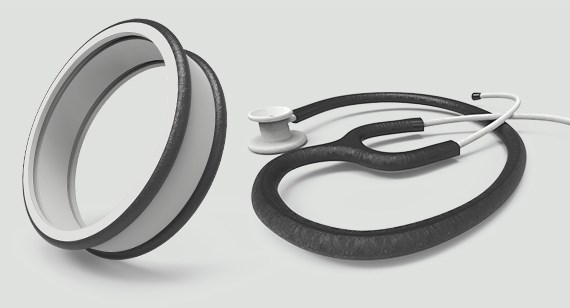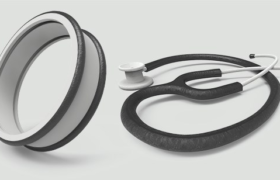PolyJet is one of the few industrial 3D printing technologies that allows the use of multiple materials in a single part build, and is one of the few technologies that can print these materials together in a single layer. In addition, different colors and hardness levels can be combined, again in a single layer just one-fourth the thickness of a sheet of printer paper.
PolyJet uses a jetting process where small droplets of liquid photopolymer, called voxels, are sprayed from multiple jets onto a build platform and cured in layers that form elastomeric parts. This digital approach provides excellent accuracy, as well as the ability to strategically alter material properties in a way never before possible.

Ready to print some PolyJet parts? Before uploading your part model, here’s a primer on this technology:
- The technical lowdown
- A brief look at which industries are using this technology and why
- Text on parts
- The playbook for part design
- Where and when you should use PolyJet
The Technical Lowdown
PolyJet has been around since 2005 and is a mature, well-understood technology. As with other 3D printing processes, it builds parts from the bottom up, one layer at time. But that’s where most of the similarities end. PolyJet uses a print head equipped with multiple jets to spray tiny droplets of liquid photopolymer 42 microns (0.00167 in.) across, forming layers just 30 microns (0.00118 in.) thick. These layers are then rapidly cured by an ultraviolet light source. Support material is printed at the same time, so PolyJet parts are self-supporting. When the build is complete, the part gets a quick bath in a chemical solution, dissolving the supports and leaving surfaces that are smooth and accurate.
One of the coolest things about PolyJet is its ability to mimic various polymers, including liquid silicone rubber (LSR) and ABS. What’s more, those materials can be printed in a range of hardness levels, making PolyJet a perfect choice for prototyping an overmolded electronics case, for example, or a housing cover with a built-in gasket, and doing so in a single build or run of the machine.
Who’s Using PolyJet?
Simply put, PolyJet is a great option for anyone who requires a fast, flexible, and accurate way of prototyping parts, but also needs the ability to incorporate multiple hardness levels (durometers) and/or material colors in a single build.
An automotive manufacturer might use it to prototype rubber seals and semi-rigid gaskets, digitally dialing in the “just right” durometer. The medical industry can use it to prototype orthopedic implants and dental prostheses for fit-testing, or create soft grips on hard plastic surgical instrument samples.
Two-toned electronics housings with clear plastic covers, flexible straps used on athletic equipment, complex appliance components, and fine-featured but flexible snap-fit cases—these are just a few of the opportunities for PolyJet prototyping of consumer and industrial goods.
The Playbook
Sounds great, but what’s the catch? Actually, the design rules for PolyJet 3D printing at FacFox are pretty easy to follow:
- The maximum part size is 19.3 in. by 15.4 in. by 7.9 in. (490mm x 390mm x 200mm).
- The minimum feature size for PolyJet parts is 0.012 in. (0.3mm) in any direction. Unsupported walls and part features can be as small as 0.030 in. (0.75mm) across, but those serving in a functional or load-bearing manner should be at least 0.040 in. (1.0mm) across. Also, the height of these features depends partly on the material and part geometry, but try to avoid very tall freestanding walls or bosses, as these can be damaged during support removal.
- Even though PolyJet can produce fine details, bear in mind that the expected length and width dimensional tolerance is +/-0.005 in. (0.1mm) for the first inch, increasing by +/-0.001 in. (0.025mm) for each additional inch. Your “mileage” may vary, depending on the part geometry and material used.
- It’s difficult to remove support material on holes, slots, and channels much smaller than 0.030 in. (0.75mm) across, especially those with a depth-to-width aspect ratio of 2:1 or greater. In fact, narrow features like this might not form properly at all, so be sure to keep this in mind on part designs. Also, you might be tempted to put in some weep holes (these allow the support material to “weep” or drain out of internal cavities) on internal “land-locked” shapes, like the inside of a cube or sphere. This is fine, provided the holes are large enough to allow rinsing of the support material, but unless there’s a compelling reason to do otherwise, just leave them closed. Chances are you won’t even notice the trapped support material.
- Prototypes for overmolded parts or those with integral gasket material—a soft touch handle, for example, or a cover containing a rubber-like sealing surface—should either be designed with zero clearance or up to 0.002 in. (0.05mm) interference fit. Leave any sort of gap and the components might come apart in your hands, leading to a redesign, reprint, and loss of time in the development cycle.
Advantages: What Can PolyJet Do for You?
FacFox uses Objet350 and Objet260 Connex3 PolyJet machines that can produce parts with a range of hardness levels, from rigid parts to flexible elastomeric ones with a Shore A hardness value of 30A (similar to the gel inserts in your shoes). Agilus materials are used for added tear resistance and tensile strength; black, white, and clear color options are standard, although custom grayscale mixtures are also available.
As with overmolded part designs, be sure to upload each piece of a “multi-part” assembly with its own separate CAD file, together with one that contains the entire assembly. Select the material hardness, color, and quantity and you’ll receive an instant quote. Once ordered, parts typically ship in 1 to 3 days.
In summary, if you’re designing a part that will be overmolded, PolyJet is for you. Prototyping a two-shot, injection-molded part? Take a look at PolyJet. Need a part that’s rigid in one area but flexible in others, or translucent in some places and opaque in others, then PolyJet might be right for your product. Working on an LSR prototype? Yep, PolyJet again.
As always, feel free to contact one of our applications engineers with any questions, at info@facfox.com.
